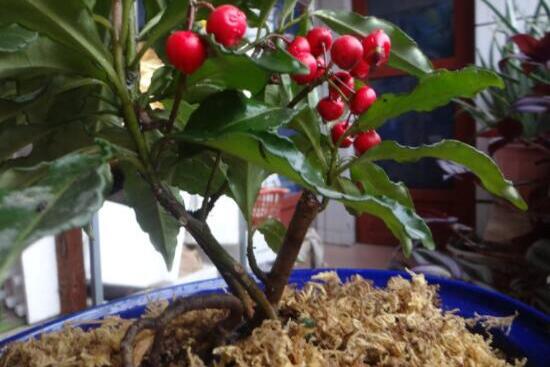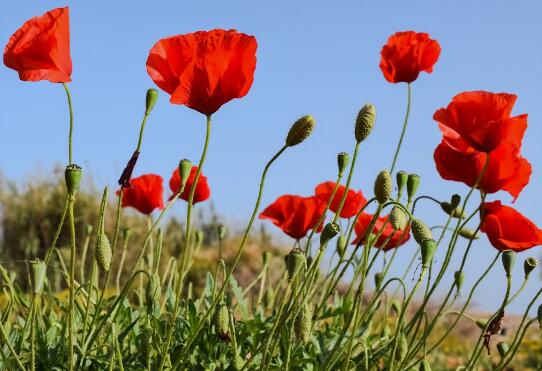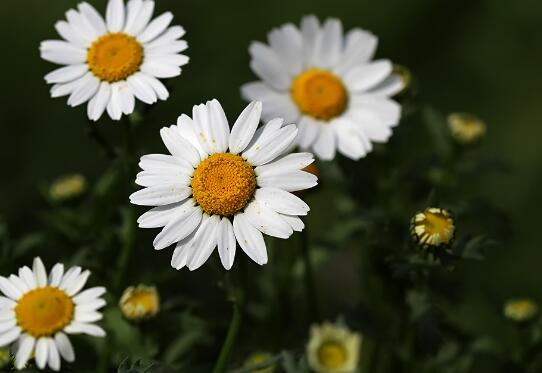How to propagate cinnabar root? propagation method of cinnabar root / 40-day rooting by cutting in April
As a kind of plant with both fruit and leaves, cinnabar root has small red fruit, which is very beautiful and festive against the green leaves. But is a pot of cinnabar root too monotonous? In this regard, some people choose to buy an extra pot, while others plan to breed on their own, so how to reproduce cinnabar root? Here are two propagation methods of cinnabar root, follow the editor to learn.
How to propagate cinnabar root, cuttage / sowing

When it comes to the propagation of cinnabar root, there is no doubt that the most common is cutting and sowing. Among them, cutting is the most common, and the propagation method is generally carried out in spring, taking the hard branches of cinnabar root as cuttings and inserting them into the soil to wait for rooting; sowing and propagation is also very simple, taking full cinnabar root seeds, shelling and sowing them on the soil, waiting for it to emerge and transplanting.
Two propagation methods of cinnabar root (1) Cuttage propagation of cinnabar root
1. Cutting time
Cinnabar root likes the warm environment, and spring and autumn is its growing season, especially from April to May, when the plant activity is the highest and the cutting survival rate is very high.
2. Cuttings selection
In the cutting propagation of cinnabar root, the selection of cuttings is particularly important, it has been selected, the whole cutting process is basically more than half successful. On the cinnabar root potted plant, one-year-old hardwood is selected and cut into 15-20 cm as cuttings. It is best to bring 2-3 leaves to the cuttings, and then treat the wound with rooting powder for cutting.
3. Cuttage starts
Insert the cuttings into the soil and the depth is 1-2-2-3 of the branches. After insertion, put the flowerpot in a shaded place and water it appropriately to keep the soil moist. Generally 40-50 days to take root, 70 days after transplanting on the pot cultivation, and then according to the cinnabar root culture methods to maintain, the next year that is, blossom and bear fruit.
(2) sowing and propagation of cinnabar root
How does cinnabar root reproduce? In addition to cutting, you can also choose the sowing method. In this method, seed selection is particularly crucial. for this, we should choose seeds with large and full particles, bright red color and no diseases and insect pests. Because the seed shell of cinnabar root is very hard, it is not easy to absorb water and germinate. So before sowing, you should remove the shell of the seed and soak the seed in warm water of 25-30 ℃ for one day.
Sowing method: after the cinnabar root seeds are selected, we will prepare a flowerpot filled with a loose, breathable and well-drained medium, and then sow the seeds on it, covering the soil no more than 0.5 cm. After that, keep the basin soil moist, and the light had better cover 90%. After the seedlings grow into true leaves, apply light fertilizer once, and transplant them when they have 4 to 5 true leaves.
With regard to the reproduction method of cinnabar root, after reading the full text, you should know how to do it! Cinnabar root is a plant, if you buy it, it will cost at least ten yuan per pot. After all, money is money, so save it if you can! And cinnabar root cutting and sowing are very simple, and the survival rate is high, so the flower friends might as well try it yourself!
Flowers can be planted and propagated in June
Leisurely June has passed halfway, and the pace of the editor is a little behind. The hot summer always reminds me that I can't even drink if I don't work well. Although I don't want to work for more than 30 days every month, I still want to tell you about the flowers planted and propagated in June.
1. Sowing seeds
The species of woody flowers that can be sown and propagated in June are: cycad, Canadian jujube, broad-leaved ten meritorious, loquat, wax plum and so on.
The species of grass flowers that can be sown in June are freesia, spring in the four seasons, and so on. Loquat sowing cover soil should not be too thick, its seed top soil ability is poor, about 2 cm thick fine soil can be covered, and then covered with straw to moisturize.
After the fruit of Chimonanthus mume is ripe, the brown seeds are removed from its pot-shaped fruit sac, soaked in cold water for 24 hours, and then buried in wet sand to accelerate budding. after about 2 weeks, the seeds can be sown only when the seeds are white, with row spacing of 15 to 20 cm, groove width of 10 cm, groove depth of 5 to 8 cm, covered with fine soil of 2 to 3 cm, and finally covered with rice straw to moisturize. When about 50% of the seeds are unearthed, gently remove the covered grass for 2 to 3 times.
2. Cuttage
June, with high temperature and humidity, is the best time for flower cutting in the courtyard.
The flowers and trees suitable for tender wood cutting in summer are: sweet-scented osmanthus, camellia, tea plum, Michelia, purple magnolia, sticky begonia, snowball, Qionghua, coral tree, rhododendron, summer cuckoo, rubber tree, spring, June snow, pomegranate, hibiscus, jasmine, pearl orchid, gardenia, five-colored plum, leaf flower, Longtuzhu, Luohansong, red back cinnamon, Hypericum, Fusang, oleander, cinnamon, incense, variegated wood, crape myrtle, crape myrtle, Sea immortal, hemp leaf hydrangea, broad leaf ten merit, wax plum, star anise gold plate, yellow poplar, eight immortal flowers, poinsettia, red leaf plum.
The species of courtyard grass suitable for cutting propagation in June are: red, thousand-day red, golden lotus, umbrella grass, bamboo begonia, colored leaf grass, peacock grass, marigold, red and green grass, chrysanthemum, begonia, perfume grass, Parthenocissus and so on.
The following is an introduction to summer planting techniques, taking tea plum, Japanese cinnamon and camellia as examples. From the first and middle of June to the end of July, when the newly drawn tender shoots are semi-lignified, they are cut for cuttings. The substrate is made of yellow soil, vermiculite and perlite, and it is best to mix the alkaline rice chaff ash with river sand at the ratio of 2:1.
The cuttings grow into ear segments of about 10 to 15 cm, leaving only the upper 2 to 3 leaves. Soak the lower incision with 500ml / kg No. 1 rooting powder solution for 10 seconds, take it out and air it slightly, wait for the alcohol in the solution to volatilize before cutting. Generally, the depth of cutting into the soil is about 1-2 to 1-3 of ear length, and the row spacing of plants is 3 × 8 cm, with leaves not covering each other. After watering the seedling bed with a spray pot, set up a bamboo bow on the seedling bed, cover it with plastic plastic film to moisturize, press the plastic film tightly around it, build a shade at the same time, maintain the temperature of the bed not higher than 30 ℃, keep it moist all the time, drain the stagnant water in the trail ditch in time in rainy days, and take root in a large amount after a month.
3. Grafting
In the courtyard in June, potted seedlings of Chimonanthus mume can be used as rootstocks to connect the fine varieties of Chimonanthus praecox. But the rootstock had better not use willow leaf Chimonanthus, because its growth rate is obviously slower than the scion, which can easily lead to the abnormal phenomenon of upper thick and lower fine.
Use potted Magnolia or Magnolia seedlings as rootstocks to connect white orchids.
The wild rose seedling was used as the rootstock and the excellent variety rose was budded.
At the end of June, the seedlings of hairy peach were used as rootstock, and red leaf plum, blue peach, purple leaf peach, Birthday Bun with Bean Paste Filling and so on were budded.
Camellia and tea plum were grafted on twigs with single camellia seedlings as rootstocks.
The seedlings of daidai were used as rootstock and the twigs were grafted with daidai.
Take tassel as rootstock, rely on Jin Gui, Yin Gui.
In addition, the grafting of tree peony can be carried out in June.
4. Pressing strip
The seedlings that can be crushed and propagated in the courtyard in June are: rhododendron, eight immortal flowers, brocade flowers, oleander, Milan, pearl orchid, red maple, jasmine, white orchid, rubber tree, wax plum, sweet-scented osmanthus, camellia, Michelia, snowball, Qionghua, hypericum, spring welcome, plum blossom.
5. Ramet
The flower species that can be propagated in the courtyard in June are: kidney fern, horseshoe lotus, parasol grass, purple evergreen, silver vein along the step grass, pineapple, 12 rolls, one-leaf orchid, hanging orchid, calamus, big leaf Ophiopogon, Ophiopogon, onion orchid, Caragana, hypericum.
Which flowers are suitable for breeding at the turn of autumn and winter
The season of replacement of autumn and winter is an adaptive stage of flowers, at this time their growth is relatively slow, so not all flowers and plants can survive for reproduction. Now I would like to introduce to you which flowers are suitable for reproduction and cultivation at the turn of autumn and winter. For flowers for reference. 1. Sowing and reproduction: the flowers and plants that can be sown in the greenhouse are: Golden Lotus, Big Rock Tree, Begonia bulb, cyclamen, African Chrysanthemum, Gentleman, asparagus, Hosta and so on. The flowers and trees that can be picked and sown are: hemp leaf hydrangea, lobular privet, privet, camphor, pencil cypress, bamboo cypress, Luohansong, no-trouble seed, rich seed (cinnabar root), palm, French holly, heather, cypress and so on. 2. Cutting propagation: it is feasible to cut in the open field, but it must be covered with plastic film. the main types of flowers and trees for heat preservation and cold protection are: red leaf plum, plum blossom (green calyx, palace powder, etc.), rose (abundant rose, Elizabeth and other easy rooting varieties), sticking begonia and so on. The species of flowers and trees that can be propagated by root insertion are: red leaf plum, weeping begonia, sticking stem begonia, medlar bone, holly, Lingxiao, hammer elm, June snow and so on. Some of these root seedlings can be used to make small, miniature bonsai. The flowers and trees that can be closely planted and propagated in the greenhouse or greenhouse are: melon seed and yellow poplar, sparrow tongue yellow poplar, big leaf yellow poplar, silver edge yellow poplar, cold water spray, Phnom Penh privet, gardenia, hypericum, golden plum, ten great efforts, Phnom Penh June snow and so on. If properly managed, flowers and plants cut in November can grow intact roots next spring, which can be used to cultivate balls for green modeling. In winter, bamboo crabapple, borer leaf begonia, lotus leaf begonia, geranium, Fusang, hanging bell begonia, Yushu, purslane, red back cinnamon, golden bract, shrimp flower and so on can be cut and propagated in the greenhouse. In the Yangtze River basin, ear strips such as hibiscus, Lingxiao and grape can also be cut for storage, and cutting in the next spring can obviously accelerate the rooting speed and improve the survival rate of cutting. 3. Grafting propagation: red maple and feather maple were grafted with green maple seedlings as rootstocks, apricot seedlings and peach seedlings as rootstocks, plum blossom cut (grafting joint buried in soil for overwintering) Using the sturdy branches of rose (Elizabeth variety) as rootstocks and superior varieties of rose branches as scions, split grafting or cutting were carried out and then cuttings were carried out to promote the synchronization of interface healing and lower incision rooting, which can speed up the process of cultivating grafted seedlings of rose varieties. 4. Striping propagation: the main species of flowers and trees that can be propagated under low pressure in November are: Begonia, Gardenia jasminoides, gardenia lobular, pomegranate, camellia, plum blossom, wax plum, Luohansong, brocade flower, sweet-scented osmanthus, eight immortal flowers, purple magnolia, emerald cypress, Michelia, hemp leaf hydrangea, snowball, Qionghua, spray snowflake and so on. 5. Branch propagation: the woody ornamental plants that can be propagated in November are: Begonia, hemp leaf hydrangea, snow spray, safflower Spiraea, three branches, hypericum, golden plum, ten meritorious works, drunken fish grass, peony, broom, spring, golden bell, Jasmine, jasmine, Zhu Lan, Phoenix tail bamboo, Fei Baizhu and so on. In the south of the Yangtze River basin, the underground roots or tubers of Dahlia, canna and canna can be dug, stored in sand and then cut and planted in March of the following spring. The plant species that can be propagated separately are: Bletilla striata, Jian Lan, Chunlan, Cymbidium, Hosta, Purple Calyx, Shegan, Iris, ornamental pineapple, Ophiopogon, auspicious grass, onion orchid, evergreen, one-leaf orchid, rooting and so on.
- Prev

How does Yu Mei reproduce? Yu Mei's reproduction mode / sowing reproduction has a high survival rate.
Yu Mei is a kind of plant with high ornamental value, which is cultivated all over our country. As more and more people cultivate it all over the country, people are more concerned about its reproduction. How does Yu Mei reproduce? What are the breeding methods of Yu Mei? Next, the editor will take you to learn about it.
- Next

How to grow white chrysanthemum? the planting method / survival rate of white crystal chrysanthemum is as high as 90%.
Among the breeding methods of white chrysanthemum, sowing is the main method. This method has been tested by countless people, but it still has a high survival rate. However, if we want to sow successfully, there are many points we need to pay attention to. How to grow white chrysanthemum? What is the planting method of white chrysanthemum?
Related
- Fuxing push coffee new agricultural production and marketing class: lack of small-scale processing plants
- Jujube rice field leisure farm deep ploughing Yilan for five years to create a space for organic food and play
- Nongyu Farm-A trial of organic papaya for brave women with advanced technology
- Four points for attention in the prevention and control of diseases and insect pests of edible fungi
- How to add nutrient solution to Edible Fungi
- Is there any good way to control edible fungus mites?
- Open Inoculation Technology of Edible Fungi
- Is there any clever way to use fertilizer for edible fungus in winter?
- What agents are used to kill the pathogens of edible fungi in the mushroom shed?
- Rapid drying of Edible Fungi

